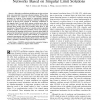Free Online Productivity Tools
i2Speak
i2Symbol
i2OCR
iTex2Img
iWeb2Print
iWeb2Shot
i2Type
iPdf2Split
iPdf2Merge
i2Bopomofo
i2Arabic
i2Style
i2Image
i2PDF
iLatex2Rtf
Sci2ools
TNN
1998
1998
Fast numerical integration of relaxation oscillator networks based on singular limit solutions
—Relaxation oscillations exhibiting more than one time scale arise naturally from many physical systems. When relaxation oscillators are coupled in a way that resembles chemical synapses, we propose a fast method to numerically integrate such networks. The numerical technique, called the singular limit method, is derived from analysis of relaxation oscillations in the singular limit. In such limit, system evolution gives rise to time instants at which fast dynamics takes place and intervals between them during which slow dynamics takes place. A full description of the method is given for a locally excitatory globally inhibitory oscillator network (LEGION), where fast dynamics, characterized by jumping which leads to dramatic phase shifts, is captured in this method by iterative operation and slow dynamics is entirely solved. The singular limit method is evaluated by computer experiments, and it produces remarkable speedup compared to other methods of integrating these systems. The sp...
| Added | 23 Dec 2010 |
| Updated | 23 Dec 2010 |
| Type | Journal |
| Year | 1998 |
| Where | TNN |
| Authors | P. S. Linsay, DeLiang L. Wang |
Comments (0)

